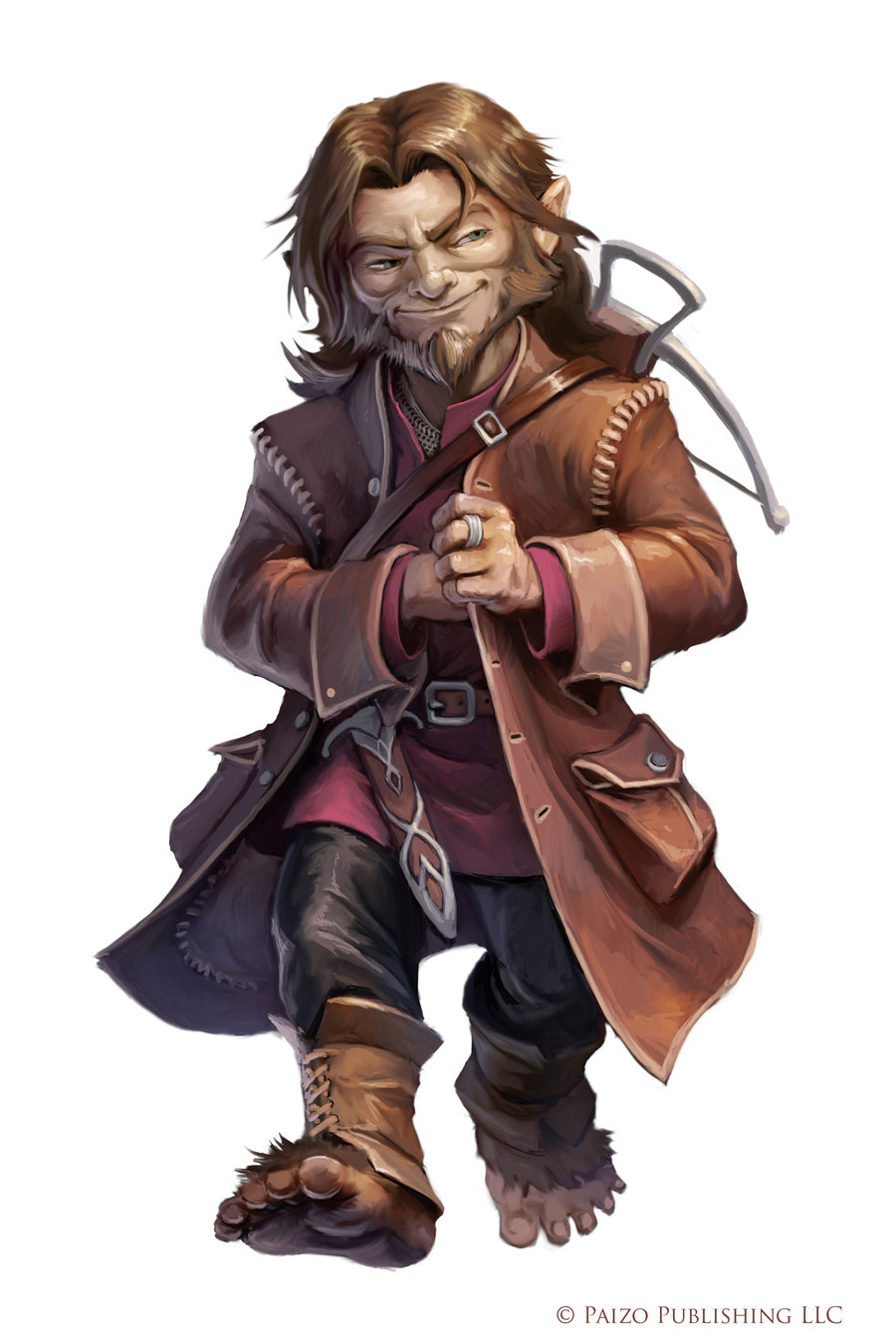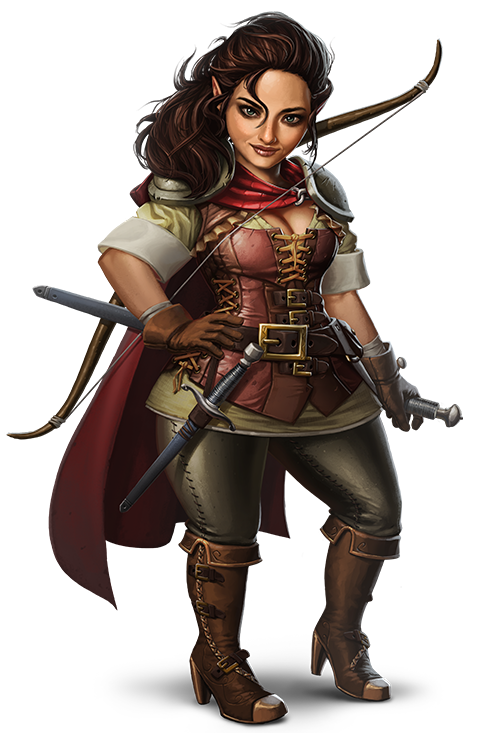Halflings
Last of the great races to choose civilization over nomadic barbarism. The halfling people watched all the other nations form but for them there was little appeal to grand cities and vast empires. Tending the land and living free was always their first and only love.
It was that connection to the land that led them to remain nomads for so long but eventually, the other races created kingdoms and with kingdoms came borders and with borders came a decision. They had to choose and that choice was harder to make than any other they’d been faced with... to pick a place and to settle. But by that time nothing was left for them to call their own.
So they took up residence in Humanity's townships and riverside communities. They ventured to the fortress-cities of the Dwarves and to the clockwork empire of the Gnomes. They went everywhere and were welcomed by all but the Elves of Melanthris. The peasantry there feared the halflings would supplant them as the perfect servants to their houses. And the nobles saw worth in the nomadic, simple paupers or their druidic magic.
When The Gates were first opened and the Autumn Queen’s voice first bled through the halflings were in no position to hear it. They had no exposure to the gates and they yearned for nothing. There was no fertile bitterness in their hearts for her words to take root. The land gave them everything they desired.
The Queen's Rebuke was as dire a blow to them as any other people. While other races were cut off from magic and from their gods the halflings lost their connection with the land and for them, this was the deepest of wounds. They left the many dead cities in the plains in search of lands they could cultivate again. They had to relearn how to farm and how to care for fields now that their shamanistic magic had withered.
Today, most halflings reside in Ghal Pelor or in her smaller townships. They’ve learned again how to farm, to live off the land and to raise cattle. The role they filled before the Queen is theirs again and it is a vital one. Halfling farmers, rangers and scholars are in high demand now, even in reluctantly in the elven peasantry.
Halflings found outside Ghal Pelor are those who seek a meaningful life beyond farming and labor. They may be young, brash members of their community out to prove their worth in the world. They also might be refugees from a township that is dying or has failed entirely. Or they could simply be hired servants, laborers, and explorers. Many of them have joined or are looking for membership in the Cartographers’ Society with hopes of one day finding a piece of land that can truly belong to the halfing people.
Basic Information
Anatomy
Short stature, large furry feet
Biological Traits
Most halflings range between 3'8 to 4'3 with the taller of them only reaching about 4'6. The average weight for a halfling is between 80 and 100 lbs.
Genetics and Reproduction
Sexual Reproduction
Ecology and Habitats
Halflings are well adapted to flatlands and grassy plains and prefer those types of environments or the general safety offered by urban settings
Dietary Needs and Habits
Halflings are rapacious eaters and enjoy virtually all known food and drink. Many of their most cherished recipes are baked goods, sweet wines, casseroles and other processed and seasoned foods.
Additional Information
Facial characteristics
Generally rounder faces and often bushier, curly or thicker hair
Geographic Origin and Distribution
Most halflings live in Ghal Pelor while some live in Homestead, Ghal Ankhar and Tengu Town.
Perception and Sensory Capabilities
Keen sense of smell compared to many other species
Civilization and Culture
Naming Traditions
Halfling naming traditions vary from region to region depending on where they settled. They often adopt naming traditions of the other races they live with. Otherwise simple traditions decided upon by the family are used
Major Organizations
Farming Cooperatives- Halflings form few organizations of real power. The only groups that hold any sway within their society and the region are the cooperatives. They are made up of family groups, farms and laborers that all work together to produce large crops and to sell them at a price that benefits the entire group.
Beauty Ideals
Halflings prefer simple beauty aesthetics. They are not concerned with things like accessories, fine clothing or beauty enhancers like make-up. They look for warm smiles, healthy bodies and curvy figures
Gender Ideals
Men are expected to be the earners and heads of the household. Women are to tend to the children, the home and social requirements.
Courtship Ideals
Simple displays of affection are the norm for halflings. Gifts such as flowers, foods and seasonings are appreciated. Modest romantic displays such as handholding in public are allowed but anything more carnal is considered to be pushing the limits of decency during the opening days of a relationship. It is a standard tradition for one member of a courting pair seek courtship permission from his partner's father.
Relationship Ideals
Most halflings crave family and friendship and view marriage the means to attain both. Large families are very common and it's rare to see an unhappy halfling couple. Partnership and love suit the halflings just fine.
Average Technological Level
Halflings have made use of the technology at the disposal of their host cities. They are quick to learn and very adaptable. Their only unique achievement is in farming skills and techniques. Halflings are generally viewed as the most talented farm hands and are renown for their ability to grow stronger crops in larger yields.
Major Language Groups and Dialects
The Common Tongue is the preferred language of halflings. While early on in their history halflings did develop a unique language of their own it was largely lost when they chose to assimilate into other cities. Only a few words and phrases of the original halfling tongue exist today.
Common Etiquette Rules
Offering food to guests is the most common practice in halfling culture. When a guest visits a halfling's home they are going to be treated to numerous offers for food and tea, usually baked goods and sweet meat
Common Dress Code
Halflings prefer simple, comfortable clothing. Since they tend to be a bit rounder and thicker they dislike tight, binding clothing. When a halfling needs to dress up they do enjoy showing off their "fancy" clothes.
Culture and Cultural Heritage
Halflings have adapted the culture and customs of the host people they live with. The only real tenant of their culture is simplicity. The grand ideals and endeavors of the other races seem daunting to halfling culture
Common Customs, Traditions and Rituals
Celebrations. Halflings enjoy large community celebrations with loud music and good food.
Meals are the other major tradition observed by halflings. There are numerous daily meals that halflings plan their chores and work tasks around. The average halfling and his family enjoy between four and nine meals a day. More during holidays.
Common Taboos
Missing a meal is generally frowned upon. The more meals missed the greater the taboo.
Overworking is also avoided. Hard work is appreciated but overfilling one's day with work that would be easily spread out or skipped without consequence is against halfling morals
Historical Figures
Halflings have no racial heroes of their own. They do appreciate the good works of the other races and their heroes but that's the extent of their hero worship. Local families, mayors and businessmen have something of a heroic reputation among their people
Common Myths and Legends
Halflings tell stories about the old tribal days before they assimilated into the cities of other races. They talk about their connection to nature and the spirits that dwell there. Myths about great halfling warriors and epic quests are generally unheard of
Origin/Ancestry
Rylan Plains
Lifespan
150-180 years
Average Physique
Most halflings would be considered stocky by human standards. They tend to carry more body fat that dwarves and gnomes.
Body Tint, Colouring and Marking
Halfling skin tones run a similar range to those of humans
Related Ethnicities




Comments